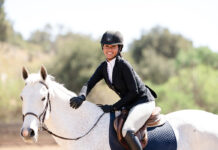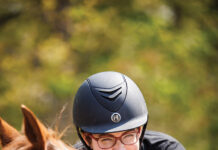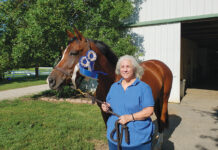
If you read Horse Illustrated, you’ve probably already seen her work. Shelley Paulson is a talented equine photographer; her photography is featured on magazine covers, in advertisements, at equine film festivals, and more.
A Day in the Life
Curious what it takes to be a pro in the field? Is it all shiny boots, pretty horses, and glamorous locales? Not so much. I tagged along with Shelley on an equestrian portrait session and quickly discovered it’s hard work nailing the perfect location, backdrop, time of day, and weather, to name just a few variables. Bug bites and sunburns are also part of the gig, as well as unpredictable equines and hours of editing and culling after the session.
Before the Shoot
It took us several weeks of rescheduling to find the right date for the shoot. Because Shelley is a natural light photographer, the sky needs to be relatively clear, and the first two times we planned to shoot, it rained.
Finally, on a promising evening with a blue sky, I drove to the picturesque town of Buffalo, Minnesota, to get a behind-the-scenes look at an equestrian portrait session featuring Kandace Hartneck Graunke and her sweet American Quarter Horse mare, Talent.

Before a shoot, Shelley keeps things simple: all of her non-photography gear—lens bag, “whinny machine ” (more on that later), leather halter, and lead—stays in her car all summer.
“I make sure I have charged batteries and clear memory cards,” she says, “and check that I have the cameras and lenses I need for the shoot, and go!”
Clients usually choose to have the session on their own farm or property; that’s where the horse and rider feel most comfortable. If it’s a farm she hasn’t visited before, she sometimes tries to scope it out ahead of time.
“I might look it up on Google satellite to get a feel for where I can find shade,” she says. “I try not to do much in the way of mental prep, as I like to keep an open mind of each session.”
Lights, Camera, Action!
The shoot itself is where the magic happens. Shelley explains when planning a session, “light trumps location every single time.” That two-hour block right before the sun goes down has the most beautiful, warm light, and that’s what she aims for each and every time she picks up her camera.
“There’s this small, magical window of time, just after the sun sets at the horizon, when the landscape and everything in it becomes softly lit, but there is still a sparkle to the light,” Shelley explains.


Shelley’s main camera is a Canon 5D Mark III, and her favorite lenses are the Canon 70-200 2.8 L IS II and the 85mm 1.2 L. If that sounds like Greek to you, you aren’t alone. What I can tell you is that each one of her lenses was very heavy, and they don’t come cheap. Looking at her stunning work, it’s clear that the high quality equipment she uses complements her high caliber skills.
Tricks Up her Sleeve
One clever trick Shelley keeps up her sleeve is her own creation—a “whinny machine.” It’s actually a compact bike speaker she filled with the sounds of horse neighs and hooves. When the button is pressed, a curious equine can’t help but look in that direction and perk its ears up. The whinny machine is ideal for capturing an alert horse with his companion. I had the chance to press the button throughout the shoot; Talent looked at me with a mixture of confusion and glee (I’m pretty sure she was thinking “How on earth did that human neigh?!”).
Each two-hour shoot is jam-packed with activity for photographer, horse, and client. We tromped around to find rich backgrounds with colorful trees and flowers, and the magical glow Shelley strives for. Again, I wondered what Kandace’s horse was thinking: why on earth are we wandering around the farm for hours on end and stopping every two minutes? But she was a trouper and seemed to bask in the attention.
All the mosquito bites and slithering snakes in Buffalo didn’t stop Shelley from using every inch of Kandace’s property (and every last speck of sunlight) to capture photo after gorgeous photo.


“One of the biggest keys to success [of a shoot] is patience,” says Shelley.
After the Shoot
The work doesn’t end when the shoot does. Much of the photographer’s work occurs after a session is over.
After her sessions, Shelley backs up the files and shares sneak peek images on Facebook, but she doesn’t do a full edit immediately. She explains, “I like to have a little mental and emotional space between the session and the edit so I can be more objective.”
Shelley usually takes around 1,200 photos per portrait session, and she presents clients with approximately 100 images. Narrowing those down for a client usually takes 30 minutes. The full editing process typically takes between two and three hours.

What is Shelley’s favorite part of a shoot? “I love every minute,” she says, “but my favorite parts are when I find amazing light and a great moment happens in that light.” Those great moments are what her photos exquisitely capture and what her clients treasure for a lifetime.
Want to learn more?
Shelley created a fantastic behind-the-scenes look at this photo shoot for her YouTube Channel:
Shelley’s YouTube channel features short videos she creates about photography, horse care, and more. You can also find her work on Facebook, Instagram, and her website, ShelleyPaulson.com.
Julia Arnold is a writer living in Minnesota with her husband and two young children. She has always loved horses and is thrilled to have officially rejoined the horse world as an adult. She rides whenever she can at Hardwood Creek Farm in Hugo,
Minnesota. You can follow her adventures in riding and parenting on Facebook, Twitter, Instagram, and Pinterest.





